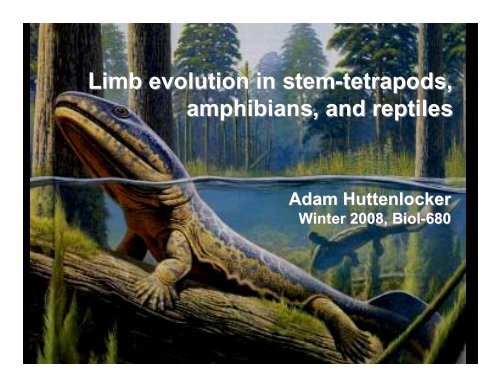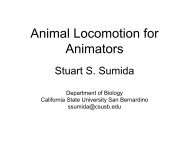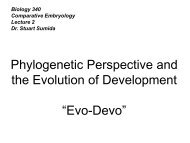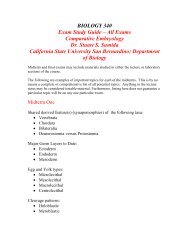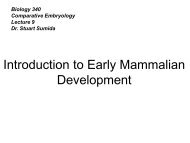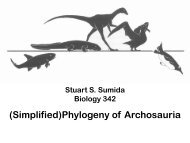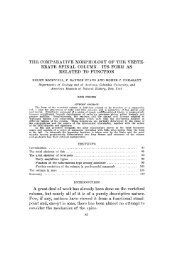Limb evolution in stem-tetrapods, amphibians ... - Dr. Stuart Sumida
Limb evolution in stem-tetrapods, amphibians ... - Dr. Stuart Sumida
Limb evolution in stem-tetrapods, amphibians ... - Dr. Stuart Sumida
Create successful ePaper yourself
Turn your PDF publications into a flip-book with our unique Google optimized e-Paper software.
<strong>Limb</strong> <strong>evolution</strong> <strong>in</strong> <strong>stem</strong>-<strong>tetrapods</strong><br />
<strong>stem</strong> <strong>tetrapods</strong>,<br />
<strong>amphibians</strong>, and reptiles<br />
Adam Huttenlocker<br />
W<strong>in</strong>ter 2008, Biol-680 Biol 680
Chapter 13: Evolution of the<br />
Appendicular Skeleton of<br />
'Amphibians'<br />
R. L. Carroll & R. B. Holmes
1. What is meant by '<strong>amphibians</strong>'?
<strong>stem</strong>-<strong>tetrapods</strong><br />
1. What is meant by '<strong>amphibians</strong>'?<br />
Lepospondyli<br />
(nectrideans, 'microsaurs', etc)<br />
Amniota<br />
Diadectomorpha<br />
Solenodonsaurus<br />
Westlothiana<br />
Seymouriamorpha<br />
Embolomeri<br />
Temnospondyli<br />
(edopoids, dv<strong>in</strong>osauroids, eryopoids,<br />
dissorophoids, stereospondyls)<br />
Baphetidae<br />
Whatcheeriidae<br />
Colosteidae<br />
Tulerpeton<br />
Hynerpeton<br />
Ichthyostega<br />
Acanthostega<br />
Diadectes (diadectomorpha)<br />
Seymouria (seymouriamorph)<br />
Dendrerpeton (temnospondyl)<br />
Oss<strong>in</strong>odus (whatcheeriid)
<strong>stem</strong>-<strong>tetrapods</strong><br />
1. What is meant by '<strong>amphibians</strong>'?<br />
crown-Tetrapoda?<br />
Lepospondyli<br />
(nectrideans, 'microsaurs', etc)<br />
Amniota<br />
Diadectomorpha<br />
Solenodonsaurus<br />
Westlothiana<br />
Seymouriamorpha<br />
Embolomeri<br />
Temnospondyli<br />
(edopoids, dv<strong>in</strong>osauroids, eryopoids,<br />
dissorophoids, stereospondyls)<br />
Baphetidae<br />
Whatcheeriidae<br />
Colosteidae<br />
Tulerpeton<br />
Hynerpeton<br />
Ichthyostega<br />
Acanthostega<br />
Diadectes (diadectomorpha)<br />
Seymouria (seymouriamorph)<br />
Dendrerpeton (temnospondyl)<br />
Oss<strong>in</strong>odus (whatcheeriid)
<strong>stem</strong>-<strong>tetrapods</strong><br />
1. What is meant by '<strong>amphibians</strong>'?<br />
crown-Tetrapoda?<br />
Lepospondyli<br />
(nectrideans, 'microsaurs', etc)<br />
Amniota<br />
Diadectomorpha<br />
Solenodonsaurus<br />
Westlothiana<br />
Seymouriamorpha<br />
Embolomeri<br />
Temnospondyli<br />
(edopoids, dv<strong>in</strong>osauroids, eryopoids,<br />
dissorophoids, stereospondyls)<br />
Baphetidae<br />
Whatcheeriidae<br />
Colosteidae<br />
Tulerpeton<br />
Hynerpeton<br />
Ichthyostega<br />
Acanthostega<br />
Diadectes (diadectomorpha)<br />
Seymouria (seymouriamorph)<br />
Dendrerpeton (temnospondyl)<br />
Oss<strong>in</strong>odus (whatcheeriid)
<strong>stem</strong>-<strong>tetrapods</strong><br />
1. What is meant by '<strong>amphibians</strong>'?<br />
crown-Tetrapoda?<br />
Lepospondyli<br />
(nectrideans, 'microsaurs', etc)<br />
Amniota<br />
Diadectomorpha<br />
Solenodonsaurus<br />
Westlothiana<br />
Seymouriamorpha<br />
Embolomeri<br />
Temnospondyli<br />
(edopoids, dv<strong>in</strong>osauroids, eryopoids,<br />
dissorophoids, stereospondyls)<br />
Baphetidae<br />
Whatcheeriidae<br />
Colosteidae<br />
Tulerpeton<br />
Hynerpeton<br />
Ichthyostega<br />
Acanthostega<br />
Diadectes (diadectomorpha)<br />
Seymouria (seymouriamorph)<br />
Dendrerpeton (temnospondyl)<br />
Oss<strong>in</strong>odus (whatcheeriid)
<strong>stem</strong>-<strong>tetrapods</strong><br />
1. What is meant by '<strong>amphibians</strong>'?<br />
crown-Tetrapoda?<br />
Lepospondyli<br />
"Anthracosauroidea"<br />
"Labyr<strong>in</strong>thodonta"<br />
crown-Tetrapoda?<br />
Lepospondyli<br />
(nectrideans, 'microsaurs', etc)<br />
Amniota<br />
Diadectomorpha<br />
Solenodonsaurus<br />
Westlothiana<br />
Seymouriamorpha<br />
Embolomeri<br />
Temnospondyli<br />
(edopoids, dv<strong>in</strong>osauroids, eryopoids,<br />
dissorophoids, stereospondyls)<br />
Baphetidae<br />
Whatcheeriidae<br />
Colosteidae<br />
Tulerpeton<br />
Hynerpeton<br />
Ichthyostega<br />
Acanthostega<br />
Diadectes (diadectomorpha)<br />
Seymouria (seymouriamorph)<br />
Dendrerpeton (temnospondyl)<br />
Oss<strong>in</strong>odus (whatcheeriid)
2. <strong>Limb</strong>s and girdles of <strong>stem</strong>-<strong>tetrapods</strong><br />
•Major trends discussed by<br />
Andrews & Westoll (1970) and<br />
more recently by Clack (1996,<br />
2002)<br />
• Early <strong>stem</strong>-<strong>tetrapods</strong><br />
(Stegocephalia) characterized by<br />
reduction of dermal elements;<br />
pelvic girdle anchored to<br />
vertebral column; zeugopod and<br />
autopod dist<strong>in</strong>ct, with wrist bones<br />
and clear "ankle" bones (tibiale,<br />
<strong>in</strong>term, fibulare); dist<strong>in</strong>ct digits<br />
with loss of dermal f<strong>in</strong> rays<br />
•Examples <strong>in</strong>clude:<br />
Acanthostega, Ichthyostega,<br />
Hynerpeton, & Tulerpeton
2. <strong>Limb</strong>s and girdles of <strong>stem</strong>-<strong>tetrapods</strong><br />
Trends <strong>in</strong> early limb girdle<br />
structure:<br />
• Parallel changes <strong>in</strong> girdle<br />
ossification (i.e., ossification<br />
centers)<br />
•Expansion of endochondral<br />
"core" / reduction of dermal<br />
components<br />
•Glenoid is "strap-like"<br />
•Pelvic girdle attaches to<br />
vertebral column<br />
Acanthostega pectoral girdle<br />
Ichthyostega pelvic girdle
2. <strong>Limb</strong>s and girdles of <strong>stem</strong>-<strong>tetrapods</strong><br />
Fore- and h<strong>in</strong>dlimbs of<br />
early <strong>stem</strong>-<strong>tetrapods</strong>:<br />
•Humerus "L-shaped"<br />
•Ulna forms a dist<strong>in</strong>ct olecranon<br />
process (e.g., Ichthyostega)<br />
•H<strong>in</strong>dlimb elements become<br />
progressively longer and<br />
cyl<strong>in</strong>drical <strong>in</strong> cross-section<br />
•Podium bears dist<strong>in</strong>ct digits (8 or<br />
less) and absence of dermal f<strong>in</strong><br />
rays<br />
Acanthostega forelimb Ichthyostega h<strong>in</strong>dlimb<br />
Tulerpeton fore- and h<strong>in</strong>dlimb
3. Carboniferous-Jurassic 'labyr<strong>in</strong>thodonts'<br />
Later 'labyr<strong>in</strong>thodonts'<br />
(general):<br />
•Gap between Upper Devonian &<br />
Visean (Mississippian) records<br />
(Tournasian or "Romer's" Gap)<br />
•Intermediate forms abundant by<br />
end-Visean, <strong>in</strong>clud<strong>in</strong>g:<br />
Colosteidae, Whatcheeriidae,<br />
Baphetidae, Crassigyr<strong>in</strong>idae, and<br />
Caerorhachis
3. Carboniferous-Jurassic 'labyr<strong>in</strong>thodonts'<br />
Romer's<br />
Gap<br />
Later 'labyr<strong>in</strong>thodonts'<br />
(general):<br />
•Gap between Upper Devonian &<br />
Visean (Mississippian) records<br />
(Tournasian or "Romer's" Gap)<br />
•Intermediate forms abundant by<br />
end-Visean, <strong>in</strong>clud<strong>in</strong>g:<br />
Colosteidae, Whatcheeriidae,<br />
Baphetidae, Crassigyr<strong>in</strong>idae, and<br />
Caerorhachis
3. Carboniferous-Jurassic 'labyr<strong>in</strong>thodonts'<br />
Romer's<br />
Gap<br />
Later 'labyr<strong>in</strong>thodonts'<br />
(general):<br />
•Gap between Upper Devonian &<br />
Visean (Mississippian) records<br />
(Tournasian or "Romer's" Gap)<br />
•Intermediate forms abundant by<br />
end-Visean, <strong>in</strong>clud<strong>in</strong>g:<br />
Colosteidae, Whatcheeriidae,<br />
Baphetidae, Crassigyr<strong>in</strong>idae, and<br />
Caerorhachis
3. Carboniferous-Jurassic 'labyr<strong>in</strong>thodonts'<br />
Colosteidae (e.g., Colosteus, Greererpeton)<br />
• Pectoral limb & girdle: loss of anocleithrum; scapulocoracoid<br />
expanded; reduction of manual digits to five (characteristic of "higher"<br />
<strong>tetrapods</strong>); manual phalangeal formula 2-3-3-4-3<br />
• Pelvic limb & girdle: dist<strong>in</strong>ct pubis, ischium, and ilium; pentadactyly;<br />
pedal phalangeal formula 2-2-3-4-2+
3. Carboniferous-Jurassic 'labyr<strong>in</strong>thodonts'<br />
Whatcheeriidae (e.g., Whatcheeria, Oss<strong>in</strong>odus)<br />
• Pectoral limb & girdle: <strong>in</strong>terclavicle reta<strong>in</strong>s long <strong>stem</strong>; enlarged<br />
humerus with more torsion<br />
• Pelvic limb & girdle: dist<strong>in</strong>ct pubis, ischium, and ilium (as <strong>in</strong><br />
colosteids); robust h<strong>in</strong>dlimb elements<br />
Oss<strong>in</strong>odus (whatcheeriid)<br />
Whatcheeria pelvic girdle Whatcheeria femur<br />
Whatcheeria humerus
3. Carboniferous-Jurassic 'labyr<strong>in</strong>thodonts'<br />
Temnospondyli (e.g.,<br />
Denderpeton, Balanerpeton,<br />
Eryops)<br />
•General characteristics:<br />
•"firm attachment of cheek to skull<br />
table"<br />
•Enlargement of <strong>in</strong>terpterygoid<br />
vacuities<br />
•Reta<strong>in</strong> contact between<br />
postparietal & supratemporal<br />
•Intercentrum usually dom<strong>in</strong>ant<br />
central element of vertebra<br />
• 2 major radiations:<br />
•Basal temnospondyl radiation<br />
•Stereospondyl radiation<br />
Dendrerpeton (temnospondyl)<br />
Lepospondyli<br />
(nectrideans, 'microsaurs', etc)<br />
Amniota<br />
Diadectomorpha<br />
Solenodonsaurus<br />
Westlothiana<br />
Seymouriamorpha<br />
Embolomeri<br />
Temnospondyli<br />
(edopoids, dv<strong>in</strong>osauroids, eryopoids,<br />
dissorophoids, stereospondyls)<br />
Baphetidae<br />
Whatcheeriidae<br />
Colosteidae
3. Carboniferous-Jurassic 'labyr<strong>in</strong>thodonts'<br />
pectoral girdle of dissorophoid, Dissorophus<br />
pectoral girdle of stereospondyl Siderops (ventral view)<br />
Temnospondyl pectoral<br />
& pelvic girdles:<br />
• pectoral girdle directly beh<strong>in</strong>d<br />
skull w/ <strong>in</strong>terclavicle project<strong>in</strong>g<br />
between jaws<br />
• <strong>in</strong>terclavicle forms broad,<br />
ventral plate, but posterior <strong>stem</strong><br />
reduced<br />
• dorsal cleithrum spoon-shaped<br />
plate that forms much of dorsal<br />
marg<strong>in</strong> of girdle<br />
• fused scapulocoracoid,<br />
although highly reduced <strong>in</strong><br />
derived stereospondyls where<br />
coracoid may be poorly ossified
3. Carboniferous-Jurassic 'labyr<strong>in</strong>thodonts'<br />
pectoral girdle of dissorophoid, Dissorophus<br />
pectoral girdle of stereospondyl Siderops (ventral view)<br />
Temnospondyl pectoral<br />
& pelvic girdles:<br />
• pectoral girdle directly beh<strong>in</strong>d<br />
skull w/ <strong>in</strong>terclavicle project<strong>in</strong>g<br />
between jaws<br />
• <strong>in</strong>terclavicle forms broad,<br />
ventral plate, but posterior <strong>stem</strong><br />
reduced<br />
• dorsal cleithrum spoon-shaped<br />
plate that forms much of dorsal<br />
marg<strong>in</strong> of girdle<br />
• fused scapulocoracoid,<br />
although highly reduced <strong>in</strong><br />
derived stereospondyls where<br />
coracoid may be poorly ossified
3. Carboniferous-Jurassic 'labyr<strong>in</strong>thodonts'<br />
Dendrerpeton pelvis <strong>in</strong> lateral (above) and ventral (below) views<br />
Temnospondyl pectoral<br />
& pelvic girdles:<br />
• iliac blade typically<br />
tall/elongate, but lack<strong>in</strong>g anterior<br />
dorsal process<br />
• triangular, plate-like ischium w/<br />
apex directed posteriorly<br />
• pubis w/ small obdurator<br />
foramen; late ossification<br />
(possibly cartilag<strong>in</strong>ous <strong>in</strong><br />
stereospondyls - Milner &<br />
Sequeira 1994)
3. Carboniferous-Jurassic 'labyr<strong>in</strong>thodonts'<br />
Temnospondyl fore- and<br />
h<strong>in</strong>dlimbs:<br />
• L-shaped humerus modified by<br />
absence of ant. crest and<br />
realignment of ectepicondyle<br />
• proximal deltopectoral crest<br />
• <strong>in</strong>creased flexibility of elbow<br />
• entepicondylar foramen lost<br />
• zeugopod highly variable<br />
• carpus often poorly ossified<br />
• 2-2-3-3 phalangeal count<br />
(Balanerpeton, Amphibamus,<br />
Micromelerpeton)<br />
Dendrerpeton humerus<br />
Balanerpeton distal forelimb<br />
Eryops humerus<br />
Eryops distal forelimb
3. Carboniferous-Jurassic 'labyr<strong>in</strong>thodonts'<br />
Temnospondyl fore- and<br />
h<strong>in</strong>dlimbs:<br />
• femur similar to Devonian<br />
<strong>tetrapods</strong>, but w/ fourth<br />
trochanter prox. <strong>in</strong> more<br />
terrestrial forms<br />
• zeugopod variable as <strong>in</strong> the<br />
forelimb<br />
• pedal phalangeal count often<br />
2-2-3-4-3 (Balanerpeton,<br />
Dissorophus, Eoscopus,<br />
Amphibamus, Tambachia?)<br />
Dendrerpeton femur Eryops femur<br />
Balanerpeton<br />
distal h<strong>in</strong>dlimb
'Anthracosauroids'<br />
•General characteristics:<br />
• posterolateral extension of the<br />
parietal to reach the tabular<br />
• retention of closed palate and<br />
mobility between skull roof and<br />
cheek<br />
• pleurocentra may fuse<br />
ventrally and become cyl<strong>in</strong>drical<br />
4. 'Anthracosauroids'<br />
Lepospondyli<br />
(nectrideans, 'microsaurs', etc)<br />
Amniota<br />
Diadectomorpha<br />
Solenodonsaurus<br />
Westlothiana<br />
Seymouriamorpha<br />
Embolomeri<br />
Temnospondyli<br />
(edopoids, dv<strong>in</strong>osauroids, eryopoids,<br />
dissorophoids, stereospondyls)<br />
Baphetidae<br />
Whatcheeriidae<br />
Colosteidae<br />
Seymouria (seymouriamorph)
Proterogyr<strong>in</strong>us pectoral girdle Seymouria pectoral girdle<br />
Proterogyr<strong>in</strong>us pectoral girdle (ventral view)<br />
4. 'Anthracosauroids'<br />
Pectoral & pelvic<br />
girdles:<br />
• anocleithrum of Devonian<br />
<strong>tetrapods</strong> largely absent, but<br />
reta<strong>in</strong>ed <strong>in</strong> Pholiderpeton and<br />
Discosauriscus, suggest<strong>in</strong>g<br />
multiple losses<br />
• scapula & coracoid dist<strong>in</strong>ct<br />
ossifications <strong>in</strong><br />
seymouriamorphs<br />
• "strap-shaped" glenoid,<br />
suggest<strong>in</strong>g little rotation<br />
• small cleithrum <strong>in</strong><br />
seymouriamorphs w/ no dorsal<br />
expansion (as <strong>in</strong> amniotes)
Eoherpeton pelvis Seymouria pelvis<br />
4. 'Anthracosauroids'<br />
Pectoral & pelvic<br />
girdles:<br />
• ilium reta<strong>in</strong>s bifurcation <strong>in</strong> early<br />
'anthracosaurs'<br />
• pubis often unossified; may be<br />
pierced by more than one<br />
foramen (e.g., Proterogyr<strong>in</strong>us)<br />
• pubis well-ossified <strong>in</strong><br />
Seymouria and Discosauriscus
Fore- and h<strong>in</strong>dlimbs:<br />
• Humerus generally reta<strong>in</strong>s<br />
primitive L-shape; prom<strong>in</strong>ent<br />
anterior crest precludes<br />
presence of dist<strong>in</strong>ct shaft<br />
• limited flexion at the elbow,<br />
due to orientation of ulnar &<br />
radial facets<br />
• generally reta<strong>in</strong> a short<br />
zeugopod<br />
• carpus is poorly known; wellossified<br />
<strong>in</strong> Seymouria (ulnare,<br />
<strong>in</strong>t., rad., pis., and two centralia<br />
as <strong>in</strong> primitive amniotes)<br />
• phalangeal formula 2-3-4-5-3<br />
as <strong>in</strong> early amniotes<br />
4. 'Anthracosauroids'<br />
Proterogyr<strong>in</strong>us humerus<br />
Proterogyr<strong>in</strong>us distal forelimb Seymouria distal forelimb
Fore- and h<strong>in</strong>dlimbs:<br />
• femur generally primitive <strong>in</strong><br />
structure<br />
• short zeugopod (55-60%<br />
length of femur)<br />
• tarsus highly variable among<br />
groups<br />
• phalangeal count usually 2-3-<br />
4-5-4 as <strong>in</strong> diadectomorphs &<br />
early amniotes<br />
4. 'Anthracosauroids'<br />
Seymouria femur Limnoscelis femur<br />
Seymouria distal h<strong>in</strong>dlimb Limnoscelis distal h<strong>in</strong>dlimb
Lepospondyls<br />
•General characteristics:<br />
• relatively small body sizes<br />
• holospondylous vertebrae as <strong>in</strong><br />
liss<strong>amphibians</strong> & amniotes<br />
• tendency for limb reduction/loss<br />
•Taxa <strong>in</strong>clude:<br />
• "microsaurs"<br />
• Nectridea<br />
• Lysorophia<br />
• Adelospondyli<br />
• Aïstopoda<br />
5. Lepospondyls<br />
Lepospondyli<br />
(nectrideans, 'microsaurs', etc)<br />
Amniota<br />
Diadectomorpha<br />
Solenodonsaurus<br />
Westlothiana<br />
Seymouriamorpha<br />
Embolomeri<br />
Temnospondyli<br />
(edopoids, dv<strong>in</strong>osauroids, eryopoids,<br />
dissorophoids, stereospondyls)<br />
Baphetidae<br />
Whatcheeriidae<br />
Colosteidae
nectridean Urocordylus<br />
shoulder girdle<br />
5. Lepospondyls<br />
nectridean Diceratosaurus<br />
shoulder girdle<br />
Pectoral & pelvic<br />
girdles:<br />
• dermal elements of shoulder<br />
girdle extensive; often fimbriated<br />
marg<strong>in</strong>s; large clavicular blades<br />
and wide, diamond-shaped<br />
<strong>in</strong>terclavicle; smooth surface <strong>in</strong><br />
"microsaurs," but deeply<br />
sculptured <strong>in</strong> nectrideans<br />
• scapulocoracoid fused but<br />
coracoid fails to ossify <strong>in</strong> some<br />
small species<br />
• helical glenoid as <strong>in</strong><br />
temnospondyls<br />
• possible cartilag<strong>in</strong>ous<br />
suprascapula as <strong>in</strong><br />
"labyr<strong>in</strong>thodonts"
microsaur Tuditanus<br />
pelvic girdle<br />
5. Lepospondyls<br />
nectridean Urocordylus<br />
pelvic girdle<br />
Pectoral & pelvic<br />
girdles:<br />
• pelvis lightly built and<br />
separated <strong>in</strong>to 3 ossifications;<br />
pubis unossified <strong>in</strong> small species<br />
• iliac processes tend to reduce<br />
dist<strong>in</strong>ction <strong>in</strong>dependently
Fore- and h<strong>in</strong>dlimb of<br />
lepospondyls:<br />
• highly variable<br />
• humerus ant. crest absent <strong>in</strong><br />
"microsaurs"; entepicondylar<br />
foramen lost <strong>in</strong> species w/ small<br />
humeri; extremely reduced <strong>in</strong><br />
lysorophians, adelospondyls, &<br />
aïstopods<br />
• stylopod & zeugopod tend to<br />
be slender and the olecranon of<br />
the ulna is lost <strong>in</strong> small forms<br />
• carpal ossifications are known<br />
<strong>in</strong> only a few "microsaurs";<br />
absent <strong>in</strong> lysorophians,<br />
adelospondyls, & aïstopods<br />
• no more than 4 manual digits<br />
<strong>in</strong> "microsaurs"<br />
5. Lepospondyls<br />
lysorophian Brachydectes forelimb<br />
Urocordylus forelimb Sauropleura forelimb
Fore- and h<strong>in</strong>dlimb of<br />
lepospondyls:<br />
• femora tend to resemble small<br />
to medium-sized temnospondyls<br />
• ends of femora tend to be<br />
<strong>in</strong>completely ossified <strong>in</strong> small,<br />
aquatic forms<br />
• zeugopod very short<br />
• pedal phalangeal count highly<br />
variable<br />
5. Lepospondyls<br />
Microsaurs Trachystegos, Rhynchonkos, and Microbrachis (femora)<br />
Microsaurs Rhynchonkos and Batropetes (distal h<strong>in</strong>dlimbs)
6. Modern lissamphibian orders<br />
Caecilians (Gymnophiona)<br />
• General: 175 spp., 6 families; Jurassic-present; modern forms are<br />
limbless; ext<strong>in</strong>ct Eocaecilia reveals aff<strong>in</strong>ities to the microsaur<br />
Rhynchonkos<br />
• Eocaecilia (Jurassic of Arizona) - scapulocoracoids, humeri, radii,<br />
ulnae, femora, tibiae, and fibulae; spiral-shaped glenoid; femur has<br />
prom<strong>in</strong>ent trochanter & resembles salamanders; 3 digits associated w/<br />
h<strong>in</strong>dlimbs
6. Modern lissamphibian orders<br />
Salamanders (Batrachia: Caudata)<br />
• General: strong evidence for temnospondyl orig<strong>in</strong>s of batrachians:<br />
pronounced metamorphosis and aquatic larvae w/ external gills<br />
Micropholis (A), Triadobatrachus (B), Notobatrachus (C), and Karaurus skeletons <strong>in</strong> dorsal view.
6. Modern lissamphibian orders<br />
Salamanders (Batrachia: Caudata)<br />
• General: strong evidence for temnospondyl orig<strong>in</strong>s of batrachians:<br />
pronounced metamorphosis and aquatic larvae w/ external gills<br />
• Pectoral & pelvic girdles - loss of all 3 dermal bones of shoulder<br />
girdle; endochondral girdle is well-ossified <strong>in</strong> hynobiids; 3 elements of<br />
pelvis reta<strong>in</strong>ed, but highly cartilag<strong>in</strong>ous<br />
Salamandra shoulder girdle<br />
Hynobius shoulder girdle<br />
Salamandra (A) and Hynobius (B-D) pelvic girdles
6. Modern lissamphibian orders<br />
Salamanders (Batrachia: Caudata)<br />
• General: strong evidence for temnospondyl orig<strong>in</strong>s of batrachians:<br />
pronounced metamorphosis and aquatic larvae w/ external gills<br />
• Forelimb & h<strong>in</strong>dlimb - humerus & femur often w/ long, slender shaft;<br />
entepicondylar foramen lost; very short zeugopods; 2-2-3-3-2 common<br />
pedal phalangeal formula (but highly variable); complete loss of<br />
h<strong>in</strong>dlimbs <strong>in</strong> sirenids; reduction of fore- and h<strong>in</strong>dlimbs <strong>in</strong> amphiumids<br />
Salamandra (E, G) and Hynobius (F, H) h<strong>in</strong>dlimbs
6. Modern lissamphibian orders<br />
Frogs (Batrachia: Anura)<br />
• General: Most highly derived h<strong>in</strong>dlimb & girdle (saltatory locomotion);<br />
modifications <strong>in</strong>volved elongation of h<strong>in</strong>dlimb, strengthen<strong>in</strong>g of<br />
zeugopod; reduction of trunk vertebrae, and consolidation of anterior<br />
caudal vertebrae <strong>in</strong>to rod-like urostyle<br />
• Pectoral & pelvic girdles - scapula and coracoid dist<strong>in</strong>ct; cleithrum and<br />
clavicle present, but <strong>in</strong>terclavicle lost; elongate iliac blade; pubis (often<br />
cartilag<strong>in</strong>ous) and ischium positioned posterior, rather than ventral<br />
Rana shoulder girdle (ventral view) Rana pelvic girdle (lateral view)
6. Modern lissamphibian orders<br />
Frogs (Batrachia: Anura)<br />
• General: Most highly derived h<strong>in</strong>dlimb & girdle (saltatory locomotion);<br />
modifications <strong>in</strong>volved elongation of h<strong>in</strong>dlimb, strengthen<strong>in</strong>g of<br />
zeugopod; reduction of trunk vertebrae, and consolidation of anterior<br />
caudal vertebrae <strong>in</strong>to rod-like urostyle<br />
• Pectoral & pelvic girdles - scapula and coracoid dist<strong>in</strong>ct; cleithrum and<br />
clavicle present, but <strong>in</strong>terclavicle lost; elongate iliac blade; pubis (often<br />
cartilag<strong>in</strong>ous) and ischium positioned posterior, rather than ventral<br />
• Fore- and h<strong>in</strong>dlimbs - humerus and femur slender; both stylopod and<br />
zeugopod elongated; tibiale and fibulare elongated; both manual<br />
(2-2-3-3) and pedal (2-2-3-4-3) phalangeal counts highly conserved
Chapter 14: <strong>Limb</strong> diversity and<br />
digit reduction <strong>in</strong> reptilian<br />
<strong>evolution</strong><br />
M. Shapiro, N. Shub<strong>in</strong>, & J. Downs
• Bones are often lost dur<strong>in</strong>g adaptive<br />
<strong>evolution</strong> of new designs<br />
•Only Sphenodon and some lizards reta<strong>in</strong><br />
the ancestral phalangeal formula<br />
• Reduction is widespread <strong>in</strong> the <strong>evolution</strong><br />
of the terrestrial vertebrate skeleton, and<br />
has been studied <strong>in</strong> salamanders,<br />
frogs, and synapsids (<strong>in</strong>cl. mammals)<br />
Sphenodon Didelphis<br />
Sphenacodontid Gorgonopsian<br />
(from Hopson 1995)
1. What is a 'reptile'?<br />
• Because "reptiles" are diagnosed<br />
by a suite of plesiomorphic<br />
characters, associated with a<br />
primitive (nonmammalian-nonavian)<br />
terrestrial lifestyle, they are<br />
Paraphyletic<br />
• Attempts have been made to<br />
designate Reptilia as monophyletic<br />
• Primitive phalangeal formula<br />
exemplified by captorh<strong>in</strong>omorphs
REPTILIA<br />
AMNIOTA<br />
DIAPSIDA<br />
EUREPTILIA<br />
ARCHOSAURI-<br />
FORMES<br />
SAURIA<br />
DINOSAURIA<br />
1. What is a 'reptile'?<br />
Avialae<br />
'Basal d<strong>in</strong>osaurs'<br />
Crocodyliformes<br />
'Basal archosaurs'<br />
Lepidosauriformes<br />
'Basal diapsids'<br />
Captorh<strong>in</strong>omorpha<br />
Parareptilia<br />
Synapsida<br />
Diadectomorpha<br />
Solenodonsaurus<br />
Archaeopteryx (avialan)<br />
Protosuchus (crocodyliform)<br />
Sphenodon (lepidosaur)<br />
Hylonomus ('protorothyridid')<br />
Sphenacodon (synapsid)
2. Construction of database<br />
and mosaic plots<br />
(1) To study trends <strong>in</strong> digit reduction, authors compiled<br />
database of phalangeal formulae from neontological &<br />
paleontological literature and museum specimens<br />
(2) Scor<strong>in</strong>g digit / phalangeal counts:<br />
• absence of digit coded "X"<br />
• reduction to metapodial coded "0"<br />
• example from Equus = X-0-3-0-X<br />
• <strong>in</strong>stances of hyperphalangy or complete limb<br />
loss excluded from analysis
2. Construction of database<br />
and mosaic plots<br />
(3) Mosaic plots:<br />
•represent "frequency of<br />
different patterns of<br />
reduction" ....<br />
Lepido<br />
Archo<br />
Caudates<br />
Manus Pes
3. Results I: Testud<strong>in</strong>es<br />
• Manus - digit I variable and often lost; digits II-V tend to<br />
reduce to similar counts (e.g., 2-2-2-2-2)<br />
• Pes - digit I always reta<strong>in</strong>s two phalanges; digit II only<br />
shows loss <strong>in</strong> 1/3 of configurations; digit III always<br />
altered from primitive condition; digits IV-V variable
4. Results II: Lepidosaurs<br />
• Manus - digit I usually either complete or absent; digit II<br />
loses either one or all phalanges (bimodal); digits<br />
III-IV variable but rarely ever lost; digit V undergoes<br />
frequent reductions<br />
• Pes - digit I frequently reduced; digit II bimodal;<br />
digits III-IV tend to lose the greatest number of<br />
phalanges (IV is usually last to be lost); digit V<br />
most frequently reduced<br />
Lepidosaurs Lerista (G-I) and Hemiergis (J) pedal configurations
5. Results III: Archosaurs<br />
• Manus - digits I-II highly conserved; digit III never lost but<br />
exhibits a whole range of phalangeal counts;<br />
tendency for reduction of digits IV-V, with extreme<br />
reduction <strong>in</strong> theropod d<strong>in</strong>osaurs<br />
• Pes - digit I has either all or none of its phalanges; digit<br />
II is never lost and has two or three phalanges;<br />
digit III usually bears four phalanges; digit IV<br />
reta<strong>in</strong>s at least four phalanges <strong>in</strong> most<br />
configurations; frequent reductions of digit V, only<br />
rhamphorhynchoid pterosaurs have more than a<br />
s<strong>in</strong>gle phalanx
6. Discussion<br />
(1) Digit reduction versus loss:<br />
•Digitreduction = loss of some or all phalanges <strong>in</strong> a digit<br />
•Digitloss = loss of all phalanges plus the support<strong>in</strong>g<br />
metapodial<br />
e.g., Lepidosaurs - often reduce both digits I & V, but patterns of<br />
complete loss vary considerably between those digits<br />
(i.e., digit V usually reta<strong>in</strong>s metapodial); digit V is highly<br />
resilient <strong>in</strong> terms of digit loss<br />
Morse's Law (1872) - I>V>II>III>IV<br />
New (manus) - I>II>V>(III,IV)<br />
New (pes) - I>II>V>III>IV<br />
* New observations follow reverse order of developmental digit<br />
primordia appearance; patterns of chondrogenesis may be a<br />
predictor of loss, but not necessarily reduction
6. Discussion<br />
(2) Integrated and correlated digit reduction:<br />
shap<strong>in</strong>g the hand and foot:<br />
• Reduction and loss of outer digits is pr<strong>in</strong>ciple mode of<br />
pedal <strong>evolution</strong> <strong>in</strong> lepidosaurs & archosaurs<br />
e.g., (0-3-4-5-X) and (X-3-4-5-X)<br />
• In archosaurs, manual digits I & II are nearly always<br />
present, whereas digits IV & V are most frequently<br />
absent<br />
• Many archosaurs and testud<strong>in</strong>es reduce the digits <strong>in</strong> a<br />
manner that they are uniform or differ only by one<br />
phalanx<br />
• Thus, similar patterns emerge <strong>in</strong> shap<strong>in</strong>g the foot that<br />
are <strong>in</strong>dependent of phylogeny
6. Discussion<br />
(3) Functional correlates of digit reduction<br />
• Reduction patterns among<br />
archosaurs correlate with functional<br />
differences ....<br />
1. Manus of theropods often reta<strong>in</strong><br />
digits I-III, but reduce/lose IV-V;<br />
retention of preaxial digits may<br />
preserve grasp<strong>in</strong>g specializations<br />
(Sereno 1997)<br />
2. Sauropods & stegosaurs may reduce<br />
to one or two phalanges across all digits<br />
3. Modest reductions associated with<br />
sprawl<strong>in</strong>g, quadrupedal gait
6. Discussion<br />
(3) Functional correlates of digit reduction<br />
• Localized outer digit reductions <strong>in</strong><br />
lepidosaurs ....<br />
• pedal configurations may<br />
lose outer digits and variably<br />
reduce central digits, unlike<br />
theropods who often conserve<br />
central digits<br />
• due to mechanical constra<strong>in</strong>ts<br />
of different locomotory means<br />
Archosaur (A-C), mammal (D-F) and lepidosaur<br />
(G-J) pedal phalangeal counts
6. Discussion<br />
(3) Functional correlates of digit reduction<br />
• Uniform reductions <strong>in</strong> turtles ....<br />
• manus & pes follow pattern<br />
of graviportal d<strong>in</strong>osaurs<br />
• most configurations bear one<br />
or two phalanges on manus<br />
& pes<br />
Graviportal d<strong>in</strong>osaur (A,B), turtle (C), and<br />
Elephas (D) manual digit reductions
6. Discussion<br />
(4) How to deconstruct a limb: developmental<br />
orig<strong>in</strong>s of limb reductions<br />
• Digit I is lost more frequently than any other digit<br />
- developmental implications: digit I can either (1) condense<br />
w/ two phalanges; (2) condense then regress;<br />
(3) not condense at all<br />
• Digit V may condense but not segment<br />
• Digits II-IV often exhibit modest reduction<br />
What changes <strong>in</strong> development might br<strong>in</strong>g about these changes?
6. Discussion<br />
(4) How to deconstruct a limb: developmental<br />
orig<strong>in</strong>s of limb reductions<br />
Changes <strong>in</strong> development ....<br />
•Reptiles offer a number of model sy<strong>stem</strong>s to study these<br />
phenomena (e.g., digit reductions, complete limb loss, etc.)<br />
• <strong>Limb</strong> bud degeneration breaks down AER w/ loss of distal<br />
signals & arrest of mesenchymal proliferation & pattern<strong>in</strong>g<br />
• experimental treatments w/ mitotic <strong>in</strong>hibitor cytos<strong>in</strong>earab<strong>in</strong>ofuranoside<br />
results <strong>in</strong> loss of peripheral digits first, then<br />
central digits<br />
• So, limb losses/reductions <strong>in</strong> <strong>evolution</strong> may be l<strong>in</strong>ked w/ shortage<br />
of tissues dur<strong>in</strong>g development ....
Lizard & salamander experiments do not necessarily show<br />
widespread truncation of rema<strong>in</strong><strong>in</strong>g digits; these represent novel<br />
configurations (e.g., Hemiergis)
7. Conclusion<br />
• Tetrapod limb reduction operates at different levels of<br />
organization (e.g., digit primordia <strong>in</strong>itiation & subsequent<br />
segmentation)<br />
• At another level, limb reduction trends likely have functional<br />
(adaptive) correlates<br />
• The last digits to form are typically the first to be lost, but<br />
losses don't follow a universal model of heterochronic truncation;<br />
truncations at <strong>in</strong>termediate stages may produce a series of<br />
<strong>in</strong>complete digits<br />
• Future studies should address whether reptile limb<br />
convergence is a product of common developmentalgenetic<br />
pathways


